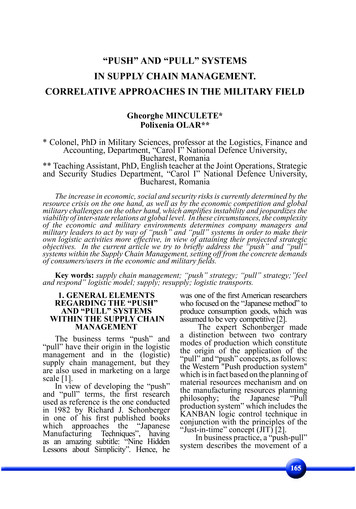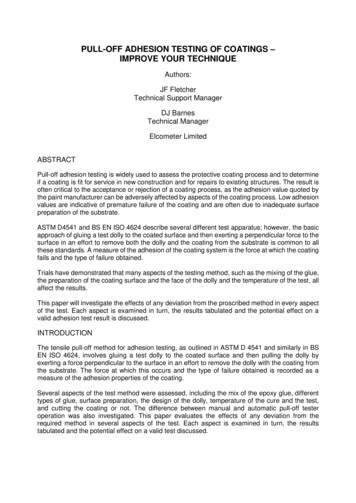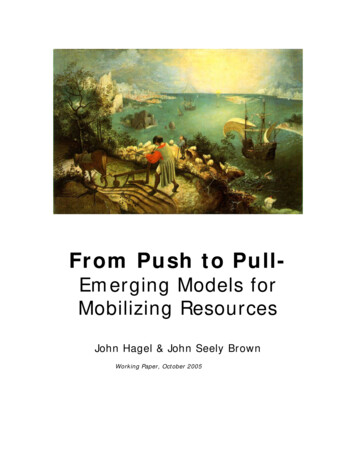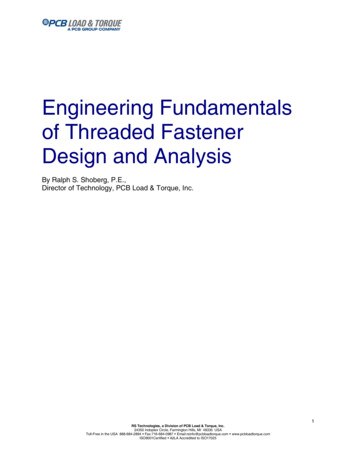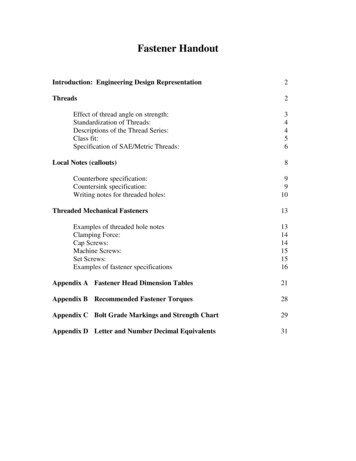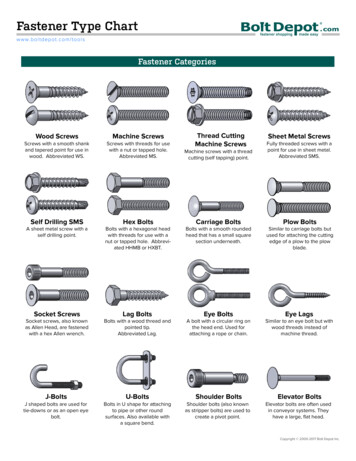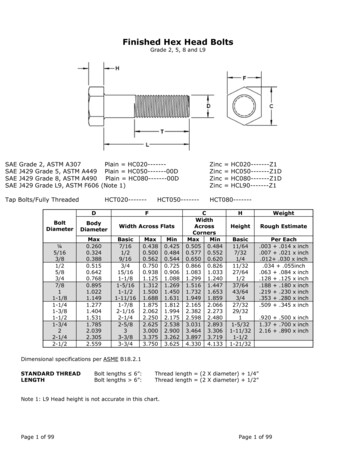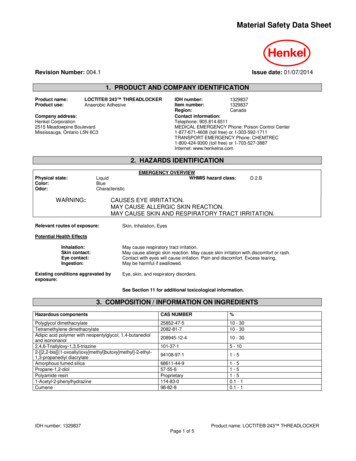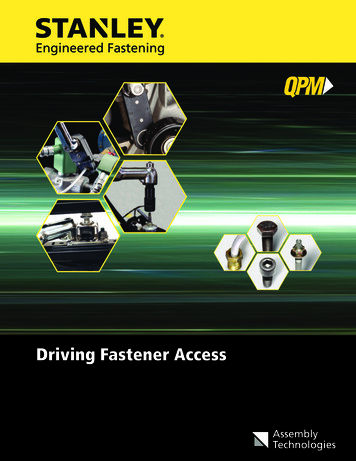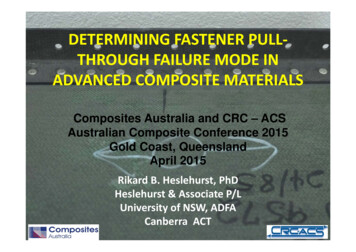
Transcription
DETERMINING FASTENER PULL‐THROUGH FAILURE MODE INADVANCED COMPOSITE MATERIALSComposites Australia and CRC – ACSAustralian Composite Conference 2015Gold Coast, QueenslandApril 2015Rikard B. Heslehurst, PhDHeslehurst & Associate P/LUniversity of NSW, ADFACanberra ACT
Outline Introduction Mechanically Fastened Joint FailureModes Fastener Pull‐Through Failure ModeMechanics Complex Failure Issues Composite Laminate MaterialProperty Estimation Parametric Study Recommended TestingMethodology Conclusions
INTRODUCTION Are mechanically fastened joints in highly loadedstructures a concern? Mechanically fastened joint efficiency is typically lessthan 100%. Metallic components have mechanically fastened jointefficiency 70%, Composite components have mechanically fastened jointefficiency 40%. Of the several mechanically fastened joint failure modesthe less common failure modes are:– cleavage failure,– bolt bending and– bolt pull-through.
INTRODUCTION For bolt pull-through the material thickness and throughthe-thickness properties are important. For composites the through-the-thickness strengthinterlaminar properties become very relevant. This paper addresses the issues, stress analysis andtesting of pull-through failure of bolted compositestructures.
MECHANICALLY FASTENED JOINT FAILUREMODESHart-Smith
FASTENER PULL‐THROUGH FAILURE MODEMECHANICS Effective FastenerHead/Washer Diameter Interlaminar Shear StrengthDeterminationP/2P/2tskinPPTTTAllowable TTT Dhead/washertlaminateFoSd (dia)
COMPLEX FAILURE ISSUESAssuming the fastener head diameteris twice the fastener shank diameterand the two components being joinedhave the same thickness then the TTTforce (F) is given by:t1FPe MDPt2Dhead3PF 5 DtF
COMPLEX FAILURE ISSUES The fastener head rotation TTTforce is distributed over aneffective arc (arc of influence) onthe structures surface. Thelarger the fastener head relativeto the fastener diameter thesmaller is the arc of influence.The arc of influence has anassumed relationship with thefastener diameter‐to‐structurethickness ratio of: The arc of influence has beendemonstrated through theapplication of holographicinterferometry on fastenertipping arc 4Dt
COMPLEX FAILURE ISSUES The initial TTT shearing stresses arebased on the arc of influencesubscribed arc length (larc) and thestructure thickness (t). The arc length is defined by:larc D8 Dt The TTT area of shear is thus:ATTTshear TTT Shear Stress is then: TTT 88P Dt 3Dt 3
COMPLEX FAILURE ISSUESTTT SHEAR STRESS/BOLT SHEAR STRESS128P10 TTT 8 bolt 6 TTT 2 bolt Dt 34P D2 t D34200.511.52D/T RATIO2.533.5
COMPOSITE LAMINATE MATERIAL PROPERTYESTIMATIONT-T-T shear failurein the x-z plane S xy S xz 1 Gm V f V f 1 S G mfxy T-T-T shear failurein the y-z plane Gm 1 V f 1 Gfyz S yz Sm Gm 1 V 1 f G fyz
COMPOSITE LAMINATE MATERIAL PROPERTYESTIMATIONNormalised Shear StrengthEffect on Shear Strengthwith Fibre Volume Ratio1.000.80 TTT 0.22 P0 0.61 Sm0.6034 TTT Sm0.400.200.0000.20.40.6Fibre Volume RatioSxy/SmSyz/Sm0.81
RECOMMENDED TESTING METHODOLOGY Symmetric Pull TestgBending support
RECOMMENDED TESTING METHODOLOGY Asymmetric Pull Test (off‐centre)Welded bracketfor inducedPtorqueLaminatedStructuregSupportingFixed FrameP
CONCLUSION Simple bolt pull-through easy to define and test. Pull through strength complex but relative simplerelationship determined through micromechanics. Tipping bolt stress state is more complex. Closedform solution difficult to develop. FEA typically bestapproach for accurate bolt tipping stresses. Experimental testing very difficult to eliminate largesecondary stresses Material property estimation very difficult todetermine, but micromechanics relationship can beused in early design.
CONCLUSION Simple analysis will get reasonable values and applylarge Factor of Safety to eliminate potential pullthrough failure. Biggest issue with thin laminates ( 8 plies) Where bolted joints are to be used 12 plies minimumis highly recommended to obtain highest jointstructural efficiency. Remember – composite structures have a lowerstructural efficiency with a bolted joint than do metalstructures.
Questions
DETERMINING FASTENER PULL ‐ . Fixed Frame P Laminated Structure g. CONCLUSION Simple bolt pull-through easy to define and test. Pull through strength complex but relative simple relationship determined through micromechanics. Tipping bolt stress state is more complex. Closed form solution difficult to develop. FEA typically best approach for accurate bolt tipping stresses .
